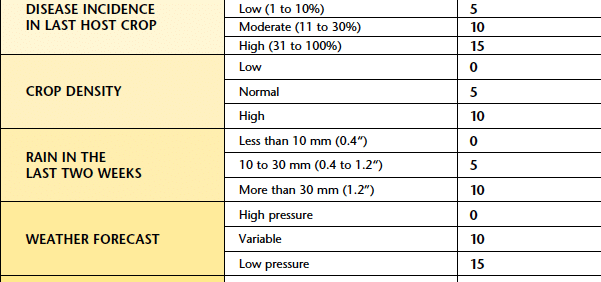If fields are moist at the time of flowering, and canola has good yield potential (e.g. 30 bu./ac. or more), then it will probably pay to spray a fungicide to limit sclerotinia losses. Please read “Factors in the sclerotinia spray decision“. Here are a few important questions about the disease:
How does sclerotinia stem rot infection occur?
Moist soils promote the growth of apothecia from sclerotia that came from previously infected plants. Apothecia eject spores into the air and wind spreads them all over the countryside. Spore release can take place over a period of weeks. These spores land everywhere, but only those that land on canola petals concern us. Ascospores need dead plant tissue to continue their cycle. Petals drop off, land in the canopy and then start to decay. These decaying petals give the sclerotinia spores the energy to produce hyphae that invade stem tissue. Because most fungicide sprays do not effectively penetrate the stem tissue to eradicate infection, living flowers are the best target for fungicides to prevent sclerotinia infection. Canola Encyclopedia chapter on sclerotinia stem rot.
How do I know if it pays to spray?
The pathogen is present across the Prairies, so if fields had moist soil ahead of flowering to promote apothecia development, and rain or high humidity during and after flowering that causes petals to stick to the plant and promote fungal growth, then infection is likely. Whether a spray pays is more difficult to answer, but moist conditions and high yield potential will likely create a favorable economic payback from a fungicide application. The sclerotinia checklist can help with the decision. Find it here under the “Management” tab.
Should fungicide be applied early, late or both?
Timing should be within the window from 20% to 50% bloom. (Some products are registered for only 20% to 30% bloom.) At 20% bloom, no petals have dropped and no pods are forming. At 30% bloom, petal drop has just begun and side branches are just starting to bloom. Canola can reach 20% flower in 4-5 days after first flower, so prepare to assess the sclerotinia stem rot risk as soon as flowering starts.
Spraying at 20% to 30% bloom ensures that a large number of flowers have opened and the spray will cover petals before they drop. But if conditions are dry at early flower and then it rains at 40-50% flower, then a later application may be more effective. Split applications (two lower rate applications 7 to 14 days apart) can be worthwhile if conditions are good for fungal growth and the crop flowers for a long period. Split applications might also be best for crops with plants at multiple stages. The first application can be made when the first plants reach recommended staging. If necessary, a second application can be made when the remaining plants are ready to be sprayed. Not all products are registered for a split application.
Are thin stands at lower risk?
Not necessarily. Conventional wisdom would be that with fewer plants per square foot, the canopy would be more open, less humid and at lower risk of infection. This might be true for a thin canopy with low yield potential. But if a canopy of 2-3 plants per square foot fills in, it will have very large plants with lots of leaf material and a longer flowering period. This could actually increase the risk of yield loss from sclerotinia because the crop is flowering longer and dropping petals into the canopy over a longer period. With larger leaves, these plants have more surface areas for petals to land.
